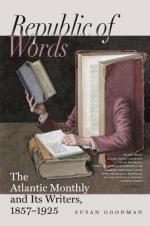Such are the stereoscope and the photograph, by the aid of which form is henceforth to make itself seen through the world of intelligence, as thought has long made itself heard by means of the art of printing. The morphotype, or form-print, must hereafter take its place by the side of the logotype, or word-print. The stereograph, as we have called the double picture designed for the stereoscope, is to be the card of introduction to make all mankind acquaintances.
The first effect of looking at a good photograph through the stereoscope is a surprise such as no painting ever produced. The mind feels its way into the very depths of the picture. The scraggy branches of a tree in the foreground run out at us as if they would scratch our eyes out. The elbow of a figure stands forth so as to make us almost uncomfortable. Then there is such a frightful amount of detail, that we have the same sense of infinite complexity which Nature gives us. A painter shows us masses; the stereoscopic figure spares us nothing,—all must be there, every stick, straw, scratch, as faithfully as the dome of St. Peter’s, or the summit of Mont Blanc, or the ever-moving stillness of Niagara. The sun is no respecter of persons or of things.
This is one infinite charm of the photographic delineation. Theoretically, a perfect photograph is absolutely inexhaustible. In a picture you can find nothing which the artist has not seen before you; but in a perfect photograph there will be as many beauties lurking, unobserved, as there are flowers that blush unseen in forests and meadows. It is a mistake to suppose one knows a stereoscopic picture when he has studied it a hundred times by the aid of the best of our common instruments. Do we know all that there is in a landscape by looking out at it from our parlor-windows? In one of the glass stereoscopic views of Table Rock, two figures, so minute as to be mere objects of comparison with the surrounding vastness, may be seen standing side by side. Look at the two faces with a strong magnifier, and you could identify their owners, if you met them in a court of law.
Many persons suppose that they are looking on miniatures of the objects represented, when they see them in the stereoscope. They will be surprised to be told that they see most objects as large as they appear in Nature. A few simple experiments will show how what we see in ordinary vision is modified in our perceptions by what we think we see. We made a sham stereoscope, the other day, with no glasses, and an opening in the place where the pictures belong, about the size of one of the common stereoscopic pictures. Through this we got a very ample view of the town of Cambridge, including Mount Auburn and the Colleges, in a single field of vision. We do not recognize how minute distant objects really look to us, without something to bring the fact home to our conceptions. A man does not deceive us as to his real size when we see him at the distance of the length of Cambridge Bridge. But hold a common black pin before the eyes at the distance of distinct vision, and one-twentieth of its length, nearest the point, is enough to cover him so that he cannot be seen. The head of the same pin will cover one of the Cambridge horse-cars at the same distance, and conceal the tower of Mount Auburn, as seen from Boston.




